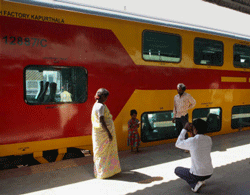
By March end, most people travelling to Chennai will likely be queuing up to travel in the new AC double-decker train, but a ride on the train might make a traveller wonder if it’s worth the trouble.
After an inspection of the seats on the train, it was apparent during a trial run for journalists here, that the coaches had little room for travellers with bigger waistline. The upper and lower decks of the train have two and three seats in a row. However, the width of the double-decker coach is lesser than a conventional coach.
Whereas a conventional coach measures 3,341 mm, the double decker coach measures 3,050 mm. As a result, the width of the seats are noticeably shorter and if anyone imagines the seats to be as comfortable like those on Shatabdi trains, they are mistaken. The difference could be clearly felt, when a slightly bigger built person attempted to sit on the seat.
Sitting becomes difficult for a person weighing around 75 kg. At 85 kg, it becomes impossible, something which led a surprised Railway official to comment: “These seats look like they are made for children. A person might have to end up booking two seats to be seated comfortably.”
Getting up from the seat and negotiating your way back into the seat is also tricky, as a tall person is likely to get a hard bump, if the passenger is not careful. This is because the ceiling and the AC vents are placed low. The coaches are also equipped with toilets which are called the controlled discharge toilet system. On this train, it means that water and waste will be stored until the train reaches a speed of 30 km/hour and then discharged into the open.
Incidentally, Railway officials expressed their surprise at the installation of this system, which has been steadily discouraged in the manufacturing of new coaches by the Railways itself. “I do not know why they have built this system. We are supporting the use of eco toilets, where the waste stored in a container is dissolved by an enzyme.
The use of controlled discharge toilets is being discouraged everywhere. Already more than 2,000 coaches have been equipped with the eco system,” Divisional Railway Manager Anil K Agarwal said.
The testing also seemed to have taken a toll on the external finish of the train, as it had scraped the platform at a couple of junctions. Stone pelting by miscreants also resulted in a few brand new windows being completely damaged. The AC double-decker coaches were first mentioned in the July 2009 Railway Budget speech by Mamata Bannerjee. The Rail Coach Factory of Kapurthala rolled out the first coach in March 2010 and the first rake was introduced on the Howrah-Dhanbad route.
Agarwal also dismissed the idea of the Bangalore division getting any more double-decker coaches on any route.
Deccan Herald is on WhatsApp Channels| Join now for Breaking News & Editor's Picks